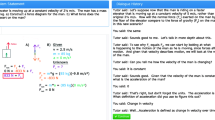Abstract
The paper deals with the problem of developing a dialogue in the interaction of a learner and Intelligent Tutoring Systems. We demonstrate the approach to synthesizing the text of a didactic dialogue on the example of using the cross-cutting approach to decision-making support by a tutoring system planner. The parametric mapping method is used for this purpose. The maps are used not only for synthesizing the explanatory text of a didactic dialogue, but also for visual representation of a learning situation in the Cognitive Maps of Knowledge Diagnosis notation. We demonstrate the process of entering a didactic dialogue and transition between dialogue forms on the example of a graduate student (course “Simulation Modeling”). The study has shown the interest of the students in receiving explanations of the ITS decisions, including both textual and visual presentation of arguments.
Access this chapter
Tax calculation will be finalised at checkout
Purchases are for personal use only
Similar content being viewed by others
Notes
References
Agarwal, A., Mishra, D.S., Kolekar, S.V.: Knowledge-based recommendation system using semantic web rules based on learning styles for MOOCs. Cogent Eng. 9(1), 2022568 (2022). https://doi.org/10.1080/23311916.2021.2022568
Alepis, E., Virvou, M., Kabassi, K.: Development process of an affective bi-modal intelligent tutoring system. Intell. Decis. Technol. 1(3), 117–126 (2007)
Arrieta, A.B., et al.: Explainable artificial intelligence (XAI): concepts, taxonomies, opportunities and challenges toward responsible AI. Inf. Fusion 58, 82–115 (2020)
Belnap, N.D., Steel, T.B.: The Logic of Questions and Answers. Yale University Press, London (1976)
Du, H., Li, N., Ma, F., Palaoag, T.: Personalization exercise recommendation based on cognitive diagnosis. In: Proceedings of the 6th International Conference on Computer Science and Application Engineering. CSAE 2022, Association for Computing Machinery, New York, NY, USA (2022). https://doi.org/10.1145/3565387.3565416
Gavrilova, T.A., Kokoulina, L.: Using ontology engineering to design an artificial intelligence course. In: Uskov, V.L., Howlett, R.J., Jain, L.C. (eds.) Smart Education and e-Learning 2019. SIST, vol. 144, pp. 201–207. Springer, Singapore (2019). https://doi.org/10.1007/978-981-13-8260-4_19
Gribova, V.V., Ostrovskii, G.E.: An intelligent cloud service for training diagnostics skills. Biomed. Eng. 51(6), 416–421 (2018). https://doi.org/10.1007/s10527-018-9761-8
Ilves, K., Leinonen, J., Hellas, A.: Supporting self-regulated learning with visualizations in online learning environments. In: Proceedings of the 49th ACM Technical Symposium on Computer Science Education, pp. 257–262. Association for Computing Machinery, New York, USA (2018). https://doi.org/10.1145/3159450.3159509
Karpenko, A., Dobryakov, A.: Model for automated training systems. overview, science and education. Sci. Educ. 7, 1–63 (2011). http://technomag.edu.ru/file/out/504730, (in Russian)
Kumar, A.N.: The effectiveness of visualization for learning expression evaluation: a reproducibility study. In: Proceedings of the 2016 ACM Conference on Innovation and Technology in Computer Science Education, pp. 192–197. ITiCSE 2016, Association for Computing Machinery, New York, NY, USA (2016). https://doi.org/10.1145/2899415.2899427
Mashbitz, E., Andrievskays, V., Komissarova, E.: Dialog in a Tutoring System. Higher school, Kiev (1989). (in Russian)
Pospelov, D., Osipov, G.: Applied semiotics. News Artif. Intell. 1, 9–35 (1999). (in Russian)
Song, Y.Y., Ying, L.: Decision tree methods: applications for classification and prediction. Shanghai Arch. psychiatry 27(2), 130 (2015). https://doi.org/10.11919/j.issn.1002-0829.215044
Stefanuk, V.L.: Learning levels in intelligent tutoring systems. IEICE Trans. Inf. Syst. 78(9), 1103–1107 (1995)
Sychev, O., Penskoy, N., Anikin, A., Denisov, M., Prokudin, A.: Improving comprehension: intelligent tutoring system explaining the domain rules when students break them. Educ. Sci. 11(11), 719 (2021). https://doi.org/10.3390/educsci11110719
Troussas, C., Krouska, A.: Path-based recommender system for learning activities using knowledge graphs. Information 14(1), 9 (2023)
Ugly, V., Zakharin, K., Baryshev, R.: Cognitive maps of knowledge diagnosis as an element of a digital educational footprint and a copyright object. In: Silhavy, R., Silhavy, P., Prokopova, Z. (eds.) CoMeSySo 2020. AISC, vol. 1295, pp. 349–357. Springer, Cham (2020). https://doi.org/10.1007/978-3-030-63319-6_31
Uglev, V., Gavrilova, T.: Cross-cutting visual support of decision making for forming personalized learning spaces. In: Krouska, A., Troussas, C., Caro, J. (eds.) Novel and Intelligent Digital Systems: Proceedings of the 2nd International Conference (NiDS 2022). NiDS 2022. Lecture Notes in Networks and Systems, vol. 556, pp. 3–12. Springer, Cham (2022). https://doi.org/10.1007/978-3-031-17601-2_1
Uglev, V., Sychev, O.: Synthesizing didactic explanatory texts in intelligent tutoring system based on the information in cognitive maps. In: Frasson, C., et al. (eds.) ITS 2023. LNCS, vol. 13891, pp. 233–246. Springer, Cham (2023)
Uglev, V., Sychev, O., Gavrilova, T.: Cross-cutting support of making and explaining decisions in intelligent tutoring systems using cognitive maps of knowledge diagnosis. In: Crossley, S., Popescu, E. (eds.) ITS 2022. Lecture Notes in Computer Science, vol. 13284, pp. 51–64. Springer, Cham (2022). https://doi.org/10.1007/978-3-031-09680-8_5
Author information
Authors and Affiliations
Corresponding author
Editor information
Editors and Affiliations
Rights and permissions
Copyright information
© 2023 The Author(s), under exclusive license to Springer Nature Switzerland AG
About this paper
Cite this paper
Uglev, V. (2023). Explanatory Didactic Dialogue in the Intelligent Tutoring Systems Based on the Cross-Cutting Approach. In: Frasson, C., Mylonas, P., Troussas, C. (eds) Augmented Intelligence and Intelligent Tutoring Systems. ITS 2023. Lecture Notes in Computer Science, vol 13891. Springer, Cham. https://doi.org/10.1007/978-3-031-32883-1_34
Download citation
DOI: https://doi.org/10.1007/978-3-031-32883-1_34
Published:
Publisher Name: Springer, Cham
Print ISBN: 978-3-031-32882-4
Online ISBN: 978-3-031-32883-1
eBook Packages: Computer ScienceComputer Science (R0)




